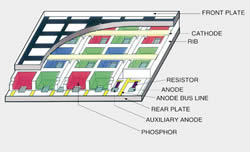| This is just an example page, if you find this a good or bad idea or want to improve or work on it your self please mail us |
You've probably heard about plasma displays -- those ultra-thin video monitors you can
hang on the wall, stand on a tabletop or suspend from the ceiling. You certainly can't
miss the commercials; one recent ad showed three industrious Gen-X types hauling a
widescreen panel into a cramped little room to watch reruns of Flipper. Clearly, the
vision of large, flat displays that was first articulated by science fiction writers in
the 1930s has been realized.
Now let's get down to business. Admit it, the thought of winning PlayStation games and
watching movies on a 16:9 screen that's not much thicker than a phone book is tempting,
right? That's what manufacturers are hoping, and the consumer press has done their best to
keep up the hype. The emergence of HDTV just adds more momentum to the plasma bandwagon,
as does the availability of widescreen (particularly anamorphic) DVDs.
There's more to the story than hype, however. Plasma panels are indeed part of the
"next wave" of video displays, along with liquid crystal display (LCD) screens
and digital light processing (DLP) gear. Although they're not your standard TV set (few
have built-in tuners), plasma display panels (PDPs) are capable of displaying everything
from NTSC signals to computer graphics.
On the other hand, PDPs are not cheap. Current models (1999 ed.) costs from about $8000 to
nearly $30,000. Moreover, as far as technology is concerned, PDPs are considered to be in
their infancy. They are also fragile, which makes shipping them a major hassle. Most
important, current models can't produce video images that look as good as your 27-inch or
32-inch direct-view TV sets without some help from external signal processors.
How it Works
Plasma displays are unique compared with other display technologies. So what's
inside that thin panel, anyway? They use a color phosphor imaging system, like
a TV set, and a fixed matrix of imaging pixels, just like an LCD. Their structure
resembles two corrugated channels laid at right angles to each other to form
tiny pixels at the channel intersections.
 Take
a microscope to those pixels and you'll see that they resemble small capacitors
with three electrodes. An electrical discharge across these electrodes causes
the rare gases sealed in the pixel to ionize and discharge ultraviolet light,
which strikes the color phosphors along the face of each pixel, causing them
to glow. The intensity and duration of that glow is determined by the charge,
sustain and discharge cycle in each pixel.
Take
a microscope to those pixels and you'll see that they resemble small capacitors
with three electrodes. An electrical discharge across these electrodes causes
the rare gases sealed in the pixel to ionize and discharge ultraviolet light,
which strikes the color phosphors along the face of each pixel, causing them
to glow. The intensity and duration of that glow is determined by the charge,
sustain and discharge cycle in each pixel.
Think of a low-voltage, lightweight TV monitor and you've got a plasma display
panel. They have wide viewing angles (up to 160 degrees, which exceeds even
conventional picture tubes) and are bright enough that you can watch them with
the lights on. Models measuring 42 inches diagonally range in weight from 73
to 100 pounds, while 50-inch versions run from about 90 to 130 pounds. The thickest
panels measure 6.2 inches, while the "slim jims" are almost half as
thick (about 3.5 inches).
Be sure to read the fine print before you buy a plasma set. Plasma monitors
are just coming into their own in terms of brightness and contrast; the brightest
models are just now approaching the light output that the aforementioned 27-inch
and 32-inch sets can produce. What's more, contrast numbers have been wildly
exaggerated. Some manufacturers have claimed as much as 500:1 image contrast,
but that's before the anti-glare glass is added to the raw panels.
The biggest obstacle that plasma panels have to overcome is their inability
to achieve a smooth ramp from full white to dark black. Low shades of gray are
particularly troublesome, and you'll often notice a posterized effect when watching
movies or other video programming with dark scenes.
In technical terms, this problem is due to insufficient quantization, or digital
sampling of brightness levels. In real world terms, it's the equivalent of trying
to fit 10 gallons of water into a 7-gallon bucket -- water (with the plasma
set, shades of gray) gets lost in the process. The bottom line is that black
level is still an issue with PDPs. I'll address quantization in depth in each
of the six plasma set review.
Quantization errors -- and the abrupt changes in luminance they create, which
are known as false contours -- aren't as big a problem when viewing static computer
images as they are when viewing video material. In fact, average brightness
levels are pretty high. As a result, plasma panels look terrific if fed a steady
diet of computer images. That's why they are adopted as "living" signs
for such public areas as airports and railroad terminals. Merchants are using
them in malls and stores, and some movie theaters are even displaying "dynamic"
movie posters and coming attractions on PDPs.
![]()
| Last Updated on 23 July 2000 | For suggestions please mail the editors |
Footnotes & References
| adapted for this site by the editors of the HoCF |